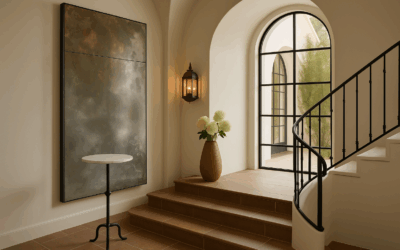Interior branding is a powerful tool that allows businesses to communicate their story and values through design elements. By strategically designing the physical spaces where business and customers interact, brands can create memorable experiences that convey their message in a unique and impactful way. The following are ways to leverage interior branding to tell your story.
Understanding the Importance of Interior Branding
Interior branding serves as a critical component of a company’s overall brand strategy. It plays a significant role in shaping customer impressions and experiences. By aligning physical spaces with brand values, businesses can create stronger connections with their audience.
Consider walking into a space that feels cluttered and mismatched. It can leave you feeling overwhelmed or even confused about the purpose of the place. Now, imagine stepping into an environment where every element complements the next, creating a seamless narrative about the brand’s ethos. That’s the power of well-executed interior branding—it allows a brand to communicate its essence without uttering a single word. It’s this silent storyteller role that makes interior branding so important.
Moreover, well-planned interior branding can differentiate a business from its competitors. While competitors might offer similar products or services, a uniquely branded interior space can offer a fresh and distinct experience which appeals to customers on a deeper level. It goes beyond visual appeal to touch on other senses and emotions, reinforcing brand loyalty and ensuring that customers remember the brand long after they’ve left. Understanding this significance can transform your approach to branding entirely.
Key Elements of Effective Interior Branding
Color schemes, furniture, lighting, and decor all contribute to the storytelling process. Selecting elements that reflect your brand’s personality creates a cohesive and inviting space. These elements offer an opportunity to subtly communicate various aspects of your brand’s narrative.
Take color, for example. Warm hues might evoke feelings of coziness and comfort, apt for brands looking to foster a welcoming environment. On the other hand, cooler tones could lend a sense of sophistication and calmness. Whatever the choice, colors should reflect the brand’s essence, connecting visitors to the story you’re aiming to express. This connection is heightened when complemented by thoughtfully chosen textures and materials, offering tactile parallels to the broader brand message. Be it smooth, sleek finishes for a tech-forward company or rustic, aged woods for a heritage-focused one, these elements must speak the same language as the overall brand narrative.
Another pivotal ingredient is lighting, which can dramatically alter the atmosphere of a space. Think of how intimate dimmed lighting can feel compared to the invigorating effect of natural sunlight pouring in. Adjustable lighting solutions that shift according to different times of day or specific events can add versatility, enhancing the storytelling capacity of a space. Every element plays a role, and when combined, they create an intricate dance that narrates your brand tale.
Incorporating Your Brand Story into Interior Design
Every business has a unique story, and interior branding is an opportunity to visually narrate it. Consider using murals, graphics, and memorabilia that highlight your brand’s journey. These personalized touches help build a deeper connection with your customers.
Start by distilling your brand story into its most compelling elements. What milestones have defined your journey? What core values set you apart? Reflecting these elements within your physical space can strengthen your brand’s presence. For instance, historical photographs, if applicable, can speak of legacy while modern art pieces can project innovation and forward-thinking. Such visual narratives enchant visitors, offering stories they can uncover and engage with, thereby making their visit more memorable and personal.
The inclusion of interactive elements can further engage visitors. Whether it’s a multimedia display sharing the brand’s history or a simple touchscreen showcasing testimonials or company achievements, technology can serve as a bridge connecting the tactile and the digital storytelling realms. This creates a dynamic space where customers interact on multiple levels, deepening their connection with the brand.
Adapting to Current Interior Design Trends
Keeping up with design trends while maintaining your brand identity is key to staying relevant. Incorporating elements like sustainable materials or technology-driven designs can demonstrate your brand’s commitment to innovation and responsibility.
The trend towards sustainability can greatly influence interior branding. Using recycled materials, energy-efficient lighting, and sustainable furniture not only reduces environmental impact but resonates with a growing demographic of eco-conscious consumers. It reflects a brand’s awareness and adaptability in an ever-evolving global context, enhancing the brand’s credibility and attractiveness.
Simultaneously, the rise of technology in design cannot be overlooked. From digital displays to smart furniture, technology offers new ways to elevate user experience and tie in modern aspects of branding. For brands that wish to be seen as innovators, integrating technology into their interior spaces can demonstrate them as forward-thinking and progressive. Adopting such trends can offer fresh perspectives without straying from a brand’s core narrative.
The Role of Emotion in Interior Branding
Spaces that evoke emotion can enhance the customer experience, making your brand more memorable. Consider how different elements might affect emotions and perceptions, ensuring they align with the feelings you wish to evoke in your audience.
Creating emotional connections through space is an art. Take scents, for instance. The subtle infusion of a signature scent can evoke nostalgia or comfort, subtly anchoring your brand in a customer’s memory. Similarly, the architectural design—like high ceilings that inspire awe or intimate nooks that invite relaxation—can elicit specific feelings. Each element within a space should work in harmony to craft the desired emotional backdrop, painting a vivid emotional landscape that speaks to customers’ hearts and minds.
Crafting Your Brand’s Story Through Interior Spaces
Interior branding is more than just making a space look good; it’s about creating an environment that resonates with your brand’s identity and values. When done right, it not only attracts customers but also helps foster brand loyalty. By understanding your story, choosing the right design elements, and adapting to trends, you can create spaces that speak volumes about who you are and what you stand for.
SOMETHING FOR EVERYONE
THE PIECES RACHEL RETURNS TO, AGAIN AND AGAIN










